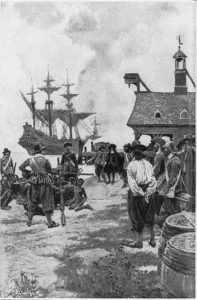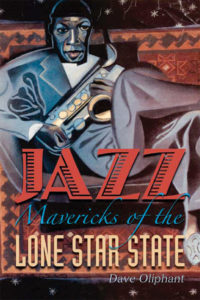For decades they hid Jefferson’s relationship with her, now Monticello is making room for Sally Hemings
(The Washington Post) The room where historians believe Sally Hemings slept was just steps away from Thomas Jefferson’s bedroom. But in 1941, the caretakers of Monticello turned it into a restroom.
The floor tiles and bathroom stalls covered over the story of the enslaved woman, who was owned by Jefferson and had a long-term relationship with him. Their involvement was a scandal during his life and was denied for decades by his descendants. But many historians now believe the third president of the United States was the father of her six children.
Time, and perhaps shame, erased all physical evidence of her presence at Jefferson’s home here, a building so famous that it is depicted on the back of the nickel.
Now the floor tiles have been pulled up and the room is under restoration — and Hemings’s life is poised to become a larger part of the story told at Monticello.
When the long-hidden space opens to the public next year, it will mark a dramatic shift in the way one of the nation’s most revered Founding Fathers is portrayed to the more than 440,000 visitors who tour this landmark annually.
It’s part of a $35 million restoration project that will bolster Monticello’s infrastructure but also reconstruct and showcase buildings where enslaved people lived and worked. The man who wrote the words “all men are created equal” in 1776 was master of a 5,000-acre working plantation who over the course of his life owned 607 slaves.
“Visitors will come up here and understand that there was no place on this mountaintop that slavery wasn’t,” said Christa Dierksheide, a Monticello historian. “Thomas Jefferson was surrounded by people, and the vast majority of those people were enslaved.” (read more)
Photo: Sam Neill and Carmen Ejogo portrayed Jefferson and Hemings in a 2000 made-for-TV movie. The story, largely ignored at Monticello for years, drew the curiosity of many authors, screenwriters and historians. (Cliff Lipson/CBS)
Kaine, Warner renew support for 400 Years of African American History Act
The first Africans brought to an English colony in North America were forcibly landed nearly 400 years ago in 1619 in modern-day Hampton. That moment launched a distressing, albeit rich history that Virginia’s senators hope to commemorate in 2019.
U.S. Sens. Tim Kaine and Mark Warner recently announced the reintroduction—along with Sen. Corey Booker of New Jersey and Sen. Roy Blunt, a Missouri Republican—of the 400 Years of African–American History Act. The measure, first introduced last year by Virginia Representatives Bobby Scott and Don Beyer, would establish a commission to plan programs and activities nationwide in 2019 recognizing the arrival, resilience, contributions and influence of Africans in America.
The commission would also acknowledge the painful impact that slavery, and laws that enforced racial discrimination, have had on the nation’s history, according to a news release from Kaine’s office.
“I’ve been lucky to be part of federal commissions that were established to study and celebrate English and Hispanic history and there is no reason a similar one shouldn’t exist to celebrate the contributions of Africans and African–Americans to our history,” he said. “We need to share the stories that explain who we are as a nation.” (read more)
Meet Stayce Harris, the first black woman to become an Air Force lieutenant general
 (Last) summer, Stayce Harris, a major general at the time, was enjoying her work as the head of the Air Force Reserve’s 22nd Air Force at Dobbins Air Reserve Base in Georgia. She commanded more than 15,000 citizen airmen, 105 aircraft and missions including a specialized hurricane hunter, fire suppression and aerial spraying.
(Last) summer, Stayce Harris, a major general at the time, was enjoying her work as the head of the Air Force Reserve’s 22nd Air Force at Dobbins Air Reserve Base in Georgia. She commanded more than 15,000 citizen airmen, 105 aircraft and missions including a specialized hurricane hunter, fire suppression and aerial spraying.
She was cool, but she knew there was more to her calling. She then learned that President Barack Obama nominated her to be promoted to lieutenant general and become the assistant vice chief of staff and director of the air staff for the U.S. Air Force.
The Senate confirmed the nomination, making her the first black woman to achieve the rank of lieutenant general for the Air Force. “I am beyond where I ever imagined I would be in life,” Harris said. “I pinch myself every single day. This opportunity, for me being on active duty for eight years then becoming an Air Force reservist for 26 years and now coming back on active duty is something that no one ever imagined, especially me, because this is a brand-new opportunity for the Air Force Reserve. It’s the first time that a reservist has held the rank of three-star lieutenant general other than the chief of the Air Force Reserve. I don’t take that lightly and I’m very honored and incredibly humbled to be able to serve in this role, and I want to do well so that we can pay it forward for others.”
Harris earned a bachelor’s degree from the University of Southern California in industrial and systems engineering, and got her master’s degree in aviation management from Embry-Riddle Aeronautical University. In her 34-year career, she’s earned many awards and boasts more than 2,500 military aircraft hours. (read more)
Why Jackie Kennedy’s wedding dress designer was fashion’s ‘best kept secret’
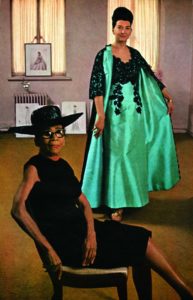
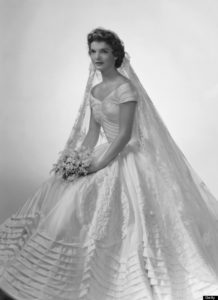 (New York Post) In 1953, when Ann Lowe received a commission to create a wedding gown for society swan Jacqueline Bouvier, she was thrilled. Lowe, an African-American designer who was a favorite of the society set, had been hired to dress the woman of the hour, the entire bridal party and Jackie’s mother. But 10 days before Jackie and Sen. John F. Kennedy were to say “I do,” a water pipe broke and flooded Lowe’s Madison Avenue studio, destroying 10 of the 15 frocks, including the bride’s elaborate dress, which had taken two months to make.
(New York Post) In 1953, when Ann Lowe received a commission to create a wedding gown for society swan Jacqueline Bouvier, she was thrilled. Lowe, an African-American designer who was a favorite of the society set, had been hired to dress the woman of the hour, the entire bridal party and Jackie’s mother. But 10 days before Jackie and Sen. John F. Kennedy were to say “I do,” a water pipe broke and flooded Lowe’s Madison Avenue studio, destroying 10 of the 15 frocks, including the bride’s elaborate dress, which had taken two months to make.
In between her tears, Lowe, then 55, ordered more ivory French taffeta and candy-pink silk faille, and corralled her seamstresses to work all day. Jackie’s dress, with its classic portrait neckline and bouffant skirt embellished with wax flowers, went on to become one of the most iconic wedding gowns in history, but, decades later, Lowe would die broke and unknown at age 82.
Now, the country’s first black high-fashion designer is finally getting her due. Three Lowe gowns are on display at the Smithsonian Institution’s new National Museum of African American History & Culture in Washington, DC. (In December), the Museum at the Fashion Institute of Technology in Manhattan displayed several Ann Lowe gowns in an exhibition on black fashion. And there are two children’s books about the designer in the pipeline.
“She was exceptional; her work really moves you,” says Smithsonian curator Elaine Nichols. (read more)
(Pictured: Left, Ann Lowe, in her New York salon with London model Judith Palmer, in 1966; right, Jackie Kennedy in Lowe-designed wedding dress.)
TIPHC Bookshelf
This Week In Texas Black History, Feb. 19-25
 19 — Most Reverend Curtis J. Guillory became the first black Catholic bishop in Texas on this day in 1988. Guillory, a native of Mallet, Louisiana, was installed as auxiliary bishop of the Catholic Diocese of Galveston-Houston. He became the fifth bishop of the 34-year-old Beaumont Diocese on July 28, 2000 and the first African-American to be bishop of Beaumont — or ordinary of any diocese in Texas, for that matter. His father’s side of the family has been traced back to France. His mother’s side of the family has been traced to the Isle Dominica in the West Indies. He is the oldest of 16 children (six sons, ten daughters).
19 — Most Reverend Curtis J. Guillory became the first black Catholic bishop in Texas on this day in 1988. Guillory, a native of Mallet, Louisiana, was installed as auxiliary bishop of the Catholic Diocese of Galveston-Houston. He became the fifth bishop of the 34-year-old Beaumont Diocese on July 28, 2000 and the first African-American to be bishop of Beaumont — or ordinary of any diocese in Texas, for that matter. His father’s side of the family has been traced back to France. His mother’s side of the family has been traced to the Isle Dominica in the West Indies. He is the oldest of 16 children (six sons, ten daughters).
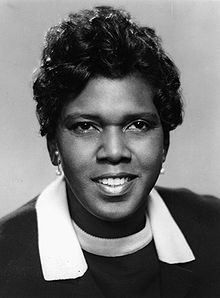 21 – On this day in 1936, Congressman Barbara Jordan was born in Houston. A graduate of Phillis Wheatley High School, Jordan was elected to the U. S. House of Representatives from the Eighteenth Texas District in 1973, becoming the first Black woman from a Southern state to serve in Congress. Jordan received the Presidential Medal of Freedom in 1994, and held the Lyndon Baines Johnson Public Service Professorship at the LBJ School of Public Affairs, University of Texas at Austin.
21 – On this day in 1936, Congressman Barbara Jordan was born in Houston. A graduate of Phillis Wheatley High School, Jordan was elected to the U. S. House of Representatives from the Eighteenth Texas District in 1973, becoming the first Black woman from a Southern state to serve in Congress. Jordan received the Presidential Medal of Freedom in 1994, and held the Lyndon Baines Johnson Public Service Professorship at the LBJ School of Public Affairs, University of Texas at Austin.
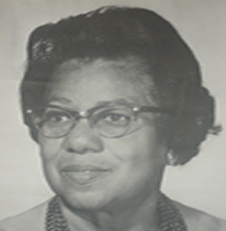 21 – Dolores Burton Linton, educator, was born on this day in 1910 in Seguin. In 1931, Linton converted a former dance hall to hold classes for black children living near San Antonio, but lacking transportation to regularly get to the city to attend school. Linton taught all six grades herself. In 1980, the Northside Independent School District named a new elementary school in her honor.
21 – Dolores Burton Linton, educator, was born on this day in 1910 in Seguin. In 1931, Linton converted a former dance hall to hold classes for black children living near San Antonio, but lacking transportation to regularly get to the city to attend school. Linton taught all six grades herself. In 1980, the Northside Independent School District named a new elementary school in her honor.
 24 – On this day in 1933, jazz saxophonist David “Fathead” Newman was born in Corsicana. Newman grew up in Dallas, graduating from Lincoln High School, then studying theology and music at Jarvis Christian College. For 12 years, beginning in 1954, he was a member of the Ray Charles Band and became the group’s lead tenor soloist. He also played with Herbie Mann, Aretha Franklin, Hank Crawford, Aaron Neville, and Austin’s Kenny Dorham. In 2005, Newman’s album, “I Remember Brother Ray,” was the most played jazz album in the nation. (See TIPHC Bookshelf for “Jazz Mavericks of the Lone Star State.”)
24 – On this day in 1933, jazz saxophonist David “Fathead” Newman was born in Corsicana. Newman grew up in Dallas, graduating from Lincoln High School, then studying theology and music at Jarvis Christian College. For 12 years, beginning in 1954, he was a member of the Ray Charles Band and became the group’s lead tenor soloist. He also played with Herbie Mann, Aretha Franklin, Hank Crawford, Aaron Neville, and Austin’s Kenny Dorham. In 2005, Newman’s album, “I Remember Brother Ray,” was the most played jazz album in the nation. (See TIPHC Bookshelf for “Jazz Mavericks of the Lone Star State.”)
Blog: Ron Goodwin, author, PVAMU history professor
 Ron Goodwin’s bi-weekly blog appears exclusively for TIPHC. Goodwin is a San Antonio native and Air Force veteran. Generally, his column addresses contemporary issues in the black community and how they relate to black history. He and the TIPHC staff welcome your comments.
Ron Goodwin’s bi-weekly blog appears exclusively for TIPHC. Goodwin is a San Antonio native and Air Force veteran. Generally, his column addresses contemporary issues in the black community and how they relate to black history. He and the TIPHC staff welcome your comments.
Read his latest entry, “Bearing His Cross,” here.
Submissions Wanted
Historians, scholars, students, lend us your…writings. Help us produce the most comprehensive documentation ever undertaken for the African American experience in Texas. We encourage you to contribute items about people, places, events, issues, politics/legislation, sports, entertainment, religion, etc., as general entries or essays. Our documentation is wide-ranging and diverse, and you may research and write about the subject of your interest or, to start, please consult our list of suggested biographical entries and see submission guidelines. However, all topics must be approved by TIPHC editors before beginning your research/writing.
We welcome your questions or comments via email or telephone – mdhurd@pvamu.edu.

